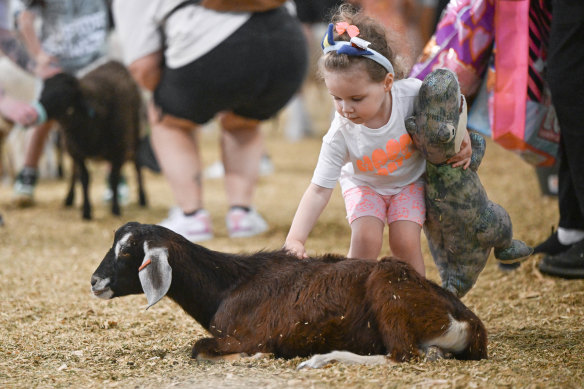This was published 8 months ago
‘We bring the country to the city’: Animals still the key to show’s success
It takes at least two trucks, multiple horse floats and at least nine hours for Alisa Harris to bring a menagerie of farm animals to the Melbourne Royal Show from her farm in NSW.
Her sheep, goats, donkeys, piglets and more are the stars of the animal nursery, where people get to cuddle, pet and occasionally hug creatures great and small.

Three-year-old Sofia gets close to a goat at the animal nursery at the Melbourne Royal Show on Friday.Credit: Joe Armao
The nursery has been a staple of the show for 60 years, and Harris has been providing animals for the show’s most popular exhibit for a decade.
While people don’t have as much experience with these animals as they used to, Harris is confident the show’s agricultural aspect won’t be going anywhere.
“We get a lot of regulars that come year after year, and … they come to see their favourite animals,” she says.
“We also get a lot of people who have never been around an animal before, and the sounds, the smells and the animals moving is a bit of shock. But when they see other people doing it, laughing and having a good time … they realise it’s calm … and everyone really does enjoy being in here.”

A delighted Darcy, 3, feeds the animals.Credit: Joe Armao
People of all ages queue for up to 20 minutes to enter the shed and, once inside, the delight is obvious. Grinning kids (and adults) eagerly feed the animals as they roam around. Some visitors even get on the ground to hug placid animals or head to pens to stroke piglets and pygmy goats.
Harris says her animals are so used to the attention that the end of the show can spell upset among her huggable livestock.
“At the end of the day when everyone leaves, that’s when they’re upset, or when we’re closed … they like being around people because they’ve grown up around people,” she says.
Harris says it’s a different group of visitors who are now interested in the agricultural side of the show.
“The people who are coming to visit don’t get the same experience as what they used to 40 or 50 years ago … you’ve got a lot of international [visitors] that have never been around animals or grew up in the city who really want to experience it,” she says.
While watching cattle judging or equestrian may not be top of people’s lists – especially when lolly-chocked showbags and rides await – the animals are still key to the show, Harris believes.
That view is echoed by Futura Kelpies owner Jack Briscoe. He breeds working dogs, and is a livestock contractor. When he started exhibiting at the show 20 years ago, more people had an understanding about livestock and farming.
“Everyone used to have a relationship or a farm or a relationship that had something to do with farming,” he says.

Jack Briscoe with Jill, his trusty six-year-old border collie. Credit: Joe Armao
Briscoe provides demonstrations at the show to enthralled crowds about how working breeds such as border collies and kelpies are used to manage sheep.
“Giving them an understanding of why we use that dog for this, and this dog for that makes them more appreciative of what the breeds and what the dogs can do,” he says.
Briscoe has noticed more people from overseas and people who grew up in cities coming to his event, and finds people are now more fearful of dogs. But he believes the royal show and its demonstrations can combat those fears, and educate people about farming.
“The times are changing, and we’ve got to adapt with everyone, but there are still crowds of people who come here, and some come back year after year,” he says.

Clydesdale breeders Jaimie (left) and Matthew Thompson.Credit: Joe Armao
Then there are newcomers such as Matthew Thompson, the owner and founder of Sandy Creek Clydesdales, who is at the show as a demonstrator for just the second time.
Thompson says people are eager to see how the draught horses are used on farms, as well as his blacksmithing displays.
He has been breeding, showing and using the horses for demonstrations for 15 years, and has seen interest grow.
“They may not be a feature of a show, but if you counted, probably three-quarters [of the people] at the show have come over and patted them,” he says of the Clydesdales.

Judging at the beef cattle competition at the show on Friday. Credit: Joe Armao
While we talk, dozens of people watch mare Peaches in her harness, and others crowd around the stables eager to pet the gentle giants. Thompson says many kids had never petted a horse or even seen a cow.
“They’re just drawn to agricultural things … it doesn’t matter where you’re from or what type of person [you are],” he says.
“We need to let people see and experience these things, and when they do it, they love it.”
Darren Keating, the show’s agriculture executive general manager, says livestock elements are the backbone of visitors’ show experience.
“They’re not going anywhere … there is not a hope of having a Melbourne show that is just rides, and showbags and food trucks because that’s not what it’s about,” Keating says.
“The key thing is that we bring the country to the city.”
Start the day with a summary of the day’s most important and interesting stories, analysis and insights. Sign up for our Morning Edition newsletter.